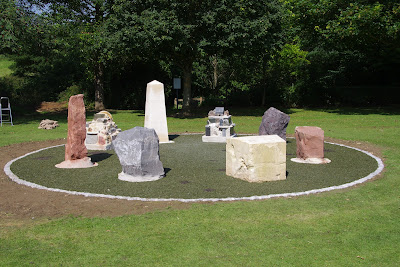Box Rock Circus
http://www.boxrockcircus.org.uk
A larger version of this and all the other photos can be seen here
There is the old saying that ‘The sun
shines on the righteous’ and this was particularly true on Thursday 9th
August 2012 when the sun blazed down for one of the few days of Summer 2012 at
the village of Box, near Corsham, Wiltshire. At 11am on that very warm morning,
the good and great (and righteous!) of Box gathered at the village recreation
ground for the unofficial unveiling of the ‘Box Rock Circus’, carried out by
the Chairman of the Box Parish Council, Pauline Lyons, to mark completion of
the construction with many villagers and children and representatives of the
press in attendance.
‘Box Rock Circus’, the brainchild of well-known
local geologist and Earth Science Educator, Elizabeth Devon, is a circular
arrangement of large stone blocks and rock sculptures designed to tell the history
of the rocks that we can see in our environment, enabling people to touch,
examine, climb on and over or just admire the originality of thought that has
produced this superb feature.
 |
| FIG 2: Elizabeth Devon, who had the original idea and designed the Box Rock Circus, stands beside the Bath Stone obelisk. Photo credit: Charles Hiscock |
The circular array contains 5 large blocks of rock donated from quarries in
differing geological areas. The Carboniferous Limestone block, packed with
fossil corals, came from Wickwar Quarry while the volcanic Silurian andesite
originates from Moon’s Hill Quarry at Stoke St Michael on Mendip. Two large
blocks of red sandstone represent the Devonian Old Red Sandstone, from Black
Mountain Quarries of Herefordshire, and the Permo-Triassic New Red Sandstone
from Capton Quarry near Williton, Somerset. Local rocks are used for the
‘table,’ cut from the Jurassic Hartham Stone, and the beautifully carved
obelisk (fig. 2) from Jurassic Box
Ground Bath Stone Quarry, the latter illustrating the importance of this fine
rock in the history of Box. The quarry has supplied fine Bath Stone for 1000
years but was closed for 60 years until it was recently reopened. Inset in the
top of the ‘table’ rock are moulds of a range of fossils (fig. 3) – Silurian trilobites, Jurassic ammonites, a Carboniferous
dragonfly, the first Cretaceous bird Archaeopteryx, starfish, a fossil worm
trail and a fish - that children (of all ages!) can reproduce in the same way
as brass rubbings. Also on the table is the badge of the Geologists’
Association which sponsored the fossil rubbings through the Curry Fund.
The
sculpted blocks are built up from specimens of different rocks and are intended
to be climbed over by children as well as examined for their content of rock
types. One is composed of sedimentary rocks and fossils sourced locally and
from further afield, topped by a polished block of Purbeck Marble sitting on a
specimen of fossil ripples (fig. 4).
The crystalline block contains specimens of igneous and metamorphic rocks, many as polished slabs as used for kitchen worktops and, completing the top, a sculpture of a tiny house built from slates, surrounded by pieces of lavas and a volcanic bomb (fig. 5).
 |
| FIG 4: The sedimentary rocks and fossils sculpture, topped by a block of Purbeck Marble. Photo credit: Charles Hiscock |
The crystalline block contains specimens of igneous and metamorphic rocks, many as polished slabs as used for kitchen worktops and, completing the top, a sculpture of a tiny house built from slates, surrounded by pieces of lavas and a volcanic bomb (fig. 5).
 |
| FIG 5: The crystalline rock sculpture, including slates, pieces of lavas and a volcanic bomb . Photo credit: Charles Hiscock |
The rocks, obelisk and sculptured blocks
are set in concrete, pinned with steel rods to the base and surrounded by a
greenish rubbery matrix made from recycled tyres providing a soft play area for
children. Made from the same material are two sets of dinosaur footprints,
coloured black which cross the circular area (fig. 6). The outside perimeter is made from granite setts which
will, in due course, be painted with red marks to show the geological timeline
and how life only evolved very recently. In fig 01, the sculpted blocks
stand either side of the obelisk, the sedimentary rocks and fossils on the left
while the crystalline rocks stand on the right. The standing stones, from left
to right around the perimeter, are Permo-Triassic New Red Sandstone,
Carboniferous Limestone, the Jurassic Box Bath Stone table, Devonian Old Red
Sandstone and Silurian andesite.
The project has received the backing of
Box Parish Council and local organisations and been funded by a Landfill
Communities Fund grant from the Hills Group Ltd. Construction of the Circus was
carried out by a team of skilled craftsmen managed by stonemason Marcus
Mitchell. The celebration on that sunny Thursday morning marked the completion
of the construction work but there is more to be done such as the red
‘timeline’ to be painted, with one year representing the age of the earth and an
interpretation board is to be set up.
The website - http://www.boxrockcircus.org.uk is to be updated to give information about the rocks and fossils and fact sheets and a childrens’ quiz will be downloadable and also available in the village.
Elizabeth
Devon will be very happy to explain the Rock Circus and can be contacted on the
Earth Learning website elizabeth@earthlearningidea.com.
The official opening is to be held later in the year on a date yet to be agreed.
Charles Hiscock




No comments:
Post a Comment